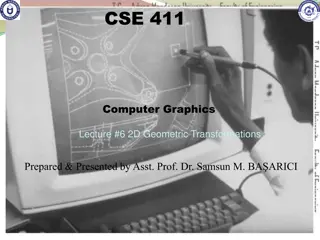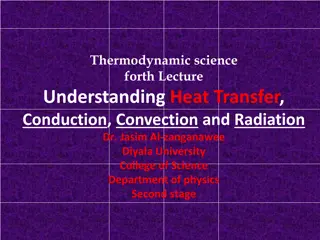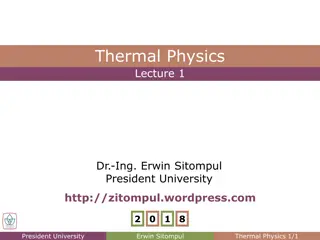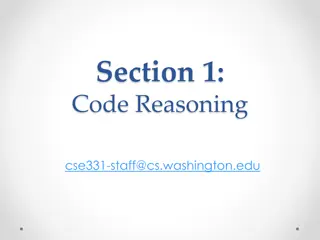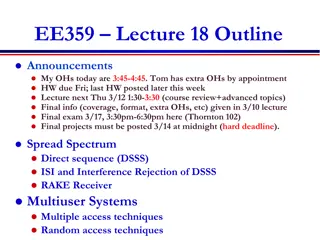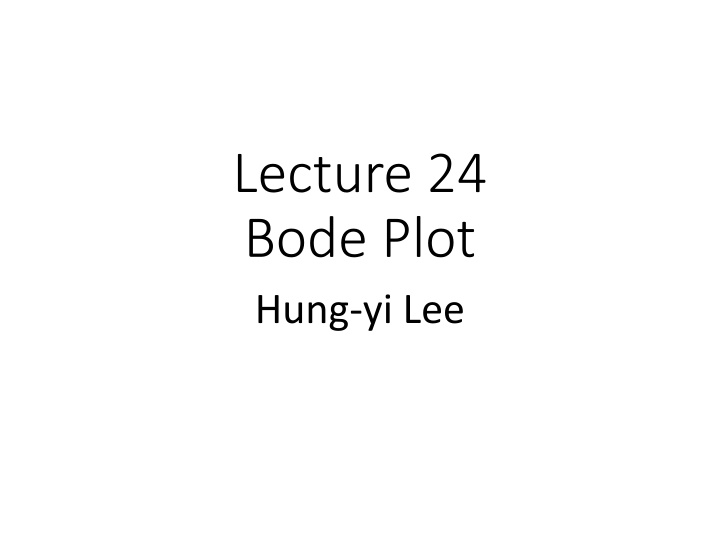
Understanding Bode Plots for System Analysis
Learn about Bode plots for analyzing system dynamics, including drawing magnitude and phase plots, understanding asymptotic lines, and interpreting real pole effects. Explore resources for creating Bode plots using MATLAB and Wolfram Alpha.
Download Presentation

Please find below an Image/Link to download the presentation.
The content on the website is provided AS IS for your information and personal use only. It may not be sold, licensed, or shared on other websites without obtaining consent from the author. If you encounter any issues during the download, it is possible that the publisher has removed the file from their server.
You are allowed to download the files provided on this website for personal or commercial use, subject to the condition that they are used lawfully. All files are the property of their respective owners.
The content on the website is provided AS IS for your information and personal use only. It may not be sold, licensed, or shared on other websites without obtaining consent from the author.
E N D
Presentation Transcript
Lecture 24 Bode Plot Hung-yi Lee
Announcement : 12/24 : Ch11.1, 11.2, 11.4
Reference Textbook: Chapter 10.4 OnMyPhD: http://www.onmyphd.com/?p=bode.plot#h3_com plex Linear Physical Systems Analysis of at the Department of Engineering at Swarthmore College: http://lpsa.swarthmore.edu/Bode/Bode.html
Bode Plot Draw magnitude and phase of transfer function ( ) a 2 10 = log a ( ) Magnitude g dB ( ) 20 log (refer to P500 of the textbook) Degree Phase ( ) 10-1 100 101 Angular Frequency (log scale) http://en.wikipedia.org/wiki/File:Bode_plot_template.pdf
Drawing Bode Plot By Computer MATLAB http://web.mit.edu/6.302/www/pz/ MIT 6.302 Feedback Systems http://www.wolframalpha.com Example Input: Bode plot of - (s+200)^2/(10s^2) By Hand Drawing the asymptotic lines by some simple rules Drawing the correction terms
Asymptotic Lines: Magnitude
Magnitude ( s )( )( ) ( )( )( ) s z s z j z j z ( ) s ( ) = = H K H K 1 2 1 2 j ( ) ( ) p s p j p j p 1 2 1 2 j z j z ( ) 1 2 = = ( ) | H j | a K j p j p 1 2 = = 20 K log + ( ) dB a + 20 log 20 log 20 log j z j z 1 2 20 log 20 log j p j p 1 2 Draw each term individually, and then add them together.
Magnitude Constant Term = + + 20 log ( ) 20 log 20 log 20 log a K j z j z 1 2 20 log 20 log j p j p 1 2 20 log K
Magnitude Real Pole = + + 20 log ( ) 20 log 20 log 20 log a K j z j z 1 2 20 log 20 log j p j p 1 2 If >> |p1| 20 j log p 1 Suppose p1is a real number j Magnitude Magnitude = = = 20 log 20 log 20 40 dB dB If = 10Hz If = 100Hz 1p Decrease 20dB per decade | | 1p If << |p1| 20 log 20 log Constant j p p 1 1
Magnitude Real Pole = + + 20 log ( ) 20 log 20 log 20 log a K j z j z 1 2 20 log 20 log j p j p 1 2 If >> |p1| 20 Constant j log p |p1| 1 j Magnitude Magnitude = = = Decrease 20dB per decade 20 log 20 log Magnitude 20 40 dB dB If = 10Hz If = 100Hz Decrease 20dB per decade If << |p1| 20 log 20 log Constant j p p 1 1 Asymptotic Bode Plot
Magnitude Real Pole If << |p1| 20 log p 1 If = |p1| j 20 log p 1 = 20 log jp p 1 1 ( | ) Cut-off Frequency (-3dB) = 20 log 2 | | p 1 = 20 log | 20 log 2 p 1 = 20 log | | 3 p 1 3dB lower
Magnitude Real Zero = + + 20 log ( ) 20 log 20 log 20 log a K j z j z 1 2 20 log 20 log j p j p 1 2 If >> |z1| 20 Suppose z1is a real number j log z 1 = j 20 log 20 log = = 20 40 Magnitude Magnitude dB dB If = 10Hz If = 100Hz 1z Increase 20dB per decade If << |z1| log 20 j | | 1z 20 log Constant z z 1 1
Magnitude Real Zero = + + 20 log ( ) 20 log 20 log 20 log a K j z j z 1 2 20 log 20 log j p j p 1 2 If >> |z1| 20 Asymptotic Bode Plot j log z 1 = Magnitude j 20 log 20 log Increase 20dB per decade = = 20 40 Magnitude Magnitude dB dB If = 10Hz If = 100Hz Increase 20dB per decade If << |z1| log 20 j 20 log Constant z z |z1| Constant 1 1
Magnitude Real Zero Problem: What if |z1| is 0? Asymptotic Bode Plot Magnitude 1z |z1| If |z1|=0, we cannot find the point on the Bode plot
Magnitude Real Zero Problem: What if |z1| is 0? If |z1|=0 Magnitude (dB) j 20 = log z 1 j 20 log = 20 log If = 0.1Hz Magnitude=-20dB Magnitude=0dB Magnitude=20dB 10 1 . 0 1 If = 1Hz If = 10Hz ( ) s rad /
Simple Examples -20dB -20dB + -20dB 1p 2 p | | | | 2 p 1p | | | | 1p 2 p -40dB +20dB -20dB -20dB + 1z 1p | | 1p | | 1z | | 1p | | 1z
Simple Examples -20dB +20dB + +20dB 1p 1z | | 1z | | 1z | | 1p | | 1p +20dB +20dB -20dB + 1z 1p | | 1p | | 1p
Magnitude Complex Poles 1 ( ) s = H The transfer function has complex poles Q 5 . 0 Q + + 2 2 0 s s 0 H j 1 If ( ) j = 0 ) H ( Q 1 1 2 0 ( ) 2 j + j + 2 0 0 ( ) j = 20 log | | 40 log H 0 constant H 20 j log = If 0 ) Q ( ) ( j ) ( + 2 0 2 j 0 H ) 2 1 ( = | | 40 log -40dB per decade
Magnitude Complex Poles The asymptotic line for conjugate complex pole pair. ( | log 20 H 1 ( ) s = H Q + + 2 2 0 s s 0 If constant ) j 0 = | 40 log 1 ( ) 0 j = H 20 log Q 1 If -40dB per decade ( ) | = j H ( ) 0 2 j + j + 2 0 0 | 40 log The approximation is not good enough peak at = 0 = Q ( ) + 2 0 2 j 0 Q ( ) j = 20 log | | 20 log H 1 ( ) 2 0 Q = H j 0 2 0 = 0+ j 40 log 20 log Q
Magnitude Complex Poles 1 ( ) s = H Q + + 2 2 0 s s 0 Height of peak: = dB Q 20 log Q Only draw the peak when Q>1 constant -40dB per decade
Magnitude Complex Poles Draw a peak with height 20logQ at 0is only an approximation Actually, Q = Q = Q = Q = Q = 1 . 1 5 . 2 5 10 67 The peak is at 1 Q 1 0 2 2 The height is 1 Q 20 log Q 1 2 4 0
Magnitude Complex Zeros +40dB per decade constant = Q 20 log Q dB
Asymptotic Lines: Phase
Phase ( s )( )( ) ( )( )( ) s z s z j z j z ( ) s ( ) = = H K H K 1 2 1 2 j ( ) ( ) p s p j p j p 1 2 1 2 ( = ) K ( ) ( ) + + j z j z 1 2 ( ) ( ) j p j p 1 2 Again, draw each term individually, and then add them together.
Phase - Constant ( ) ( ) ( ) ( ) ( = + + ) K j z j z j p j p 1 2 1 2 Two answers K K 0 0 K K
Phase Real Poles ( ) ( ) ( ) ( ) ( = + + ) K j z j z j p j p 1 2 1 2 p1is a real number If << |p1| ( ) ? j 1= p 0 If = |p1| ( ) ? j 1= p 45 1p If >> |p1| ( ) ? j 1= p 90
Phase Real Poles ( ) ( ) ( ) ( ) ( = + + ) K j z j z j p j p 1 2 1 2 p1is a real number If << |p1| ( ) j 1p ( ) ? j 1= p 0 0.1|p1| If = |p1| 0 |p1| ( ) ? j 1= p 45 10|p1| If >> |p1| ( ) ? j 1= p 90
Phase Real Poles Exact Bode Plot | 1 . 0 | 1z Asymptotic Bode Plot | | 1z 10 | | 1z
Phase Real Zeros ( ) ( ) ( ) ( ) ( = + + ) K j z j z j p j p 1 2 1 2 If z1< 0 ( ( ) ? ) ? z1is a real number j j 1= z 1= z 0 45 If << |z1| If = |z1| ( ) ? j 1= z 90 If >> |z1| ( ) 1z j 1z 90 45 |z1| 0
Phase Pole at the Origin Problem: What if |z1| is 0? + 90 1z
Phase Complex Poles 1 ( ) s = H Q + + 2 2 0 s s 0 If 0 0 If 1p 0 180 0 = If 0 90 2 p
Phase Complex Poles The red line is a very bad approximation. (The phase for complex zeros are trivial.)
Magnitude Real poles and zeros Given a pole p 0.1|P| 0.5|P| |P| 2|P| 10|P|
Magnitude Complex poles and Zeros 1 ( ) s = H Q + + 2 2 0 s s 0 1p 0 0 2 Q Computing the correction terms at 0.5 0and 2 0 2 p
Phase Real poles and zeros Given a pole p |P| 2|P| 0.1|P| 0.5|P| 10|P| 0 (We are not going to discuss the correction terms for the phase of complex poles and zeros.)
K = z 1 p 1 100 = , 2 p = , , , 0 p 50 z Exercise 11.58 2 100 400 100 , , 3 Draw the asymptotic Bode plot of the gain for H(s) = 100s(s+50)/(s+100)2(s+400) = 20log | K | 40dB K 20 log p If << |p| Decrease 20dB per decade If >> |p| - 40dB - 52dB - 40dB 1 p 2 p 3 p 100 400 100
K = z 1 p 1 100 = , 2 p = , , , 0 p 50 z Exercise 11.58 2 100 400 100 , , 3 - 40dB - 40dB - 52dB 2 p 3 p 40dB 1 p K 100 400 100 20 log z If << |z1| 1 If >> |z1| Increase 20dB per decade 2 z ( ) 1z 100 Hz 40 , dB ( ) 10 Hz 20 , dB 34dB ( ) Hz 0 , 1 dB 50
1z 2 z Exercise 11.58 34dB 50 - 40dB - 40dB - 52dB 2 p 3 p 40dB 1 p K 100 400 100 Compute the gain at =100 ? - 20dB/decad e + 40dB/decad e + 20dB/decad e 100 400 50
Compute the gain at =100 Exercise 11.58 - 40dB - 40dB - 52dB 2 p 3 p 40dB 1 p K 100 400 100 1z 40dB ( ) 2 z 100 Hz 40 , dB + 6dB 34dB ( ) 50 100 Hz 0 , 1 dB + + = 40dB 40dB 40dB 52dB 40dB 40dB 12 dB
1z 2 z Exercise 11.58 34dB 50 - 40dB - 40dB - 52dB 2 p 3 p 40dB 1 p K 100 400 100 -12dB - 20dB/decad e + 40dB/decad e + 20dB/decad e 100 400 50
Exercise 11.58 MATLAB
K = z1= p 1 8000 0 , 2 p Exercise 11.52 = , 10 , 40 , 80 p 3 Draw the asymptotic Bode plot of the gain for H(s) = 8000s/(s+10) (s+40)(s+80). Add the dB correction to find the maximum value of a( ) 78dB 1 p - 20dB - 32dB - 38dB 2 p 3 p K 40 80 1z 10 8dB 40 10 80
Exercise 11.52 Draw the asymptotic Bode plot of the gain for H(s) = 8000s/(s+10) (s+40)(s+80). Add the dB correction to find the maximum value of a( ) 8dB 40 10 80 Is 8dB the maximum value?
Exercise 11.52 Draw the asymptotic Bode plot of the gain for H(s) = 8000s/(s+10) (s+40)(s+80). Add the dB correction to find the maximum value of a( ) 78dB 1 p - 20dB - 32dB - 38dB 2 p 3 p K 40 80 1z 10 Correction 5 10 20 40 80 160 P1 p2 p3 -1dB -3dB -1dB -1dB -3dB -1dB -1dB -3dB -1dB Total -1dB -3dB -2dB -4dB -4dB -1dB
Exercise 11.52 Draw the asymptotic Bode plot of the gain for H(s) = 8000s/(s+10) (s+40)(s+80). Add the dB correction to find the maximum value of a( ) Maximum gain is about 6dB ( ) 6dB 20loga = ( ) 2 10 a = = 8dB 6 40 10 20 80 Correction 5 10 20 40 80 160 P1 p2 p3 -1dB -3dB -1dB -1dB -3dB -1dB -1dB -3dB -1dB Total -1dB -3dB -2dB -4dB -4dB -1dB
Homework 11.59, 11.60, 11.63






